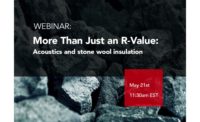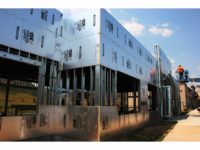Education and awareness of the need for greater energy efficiency have moved the needle for higher performance building envelopes prompting greater consideration of insulation levels, R-value, air tightness, vapor diffusion, condensation control and more. As a result, greater thought is now invested in material selection and whole system performance. One solution is stone wool rigid insulation boards which have emerged as an advantageous multi-tasking solution gaining traction among architects, designers, builders and contractors.
These board contribute to several key project goals in both residential and commercial jobs, from energy efficiency to moisture management, fire protection and sound control, as well as building resilience and sustainability, among others.
Continuous Exterior Insulation
Stone wool rigid board continues to be a popular choice for continuous exterior insulation, given its stable R-value per inch and its contribution to a building’s safety, comfort and durability. Many contractors also prefer the product for this application given its ease of handling and installation, whether installation occurs on site or in controlled environments, such as in prefabricated panels.
Energy codes are starting to require continuous exterior insulation on all commercial buildings, and it makes sense, since buildings account for approximately 40 per cent of all energy consumption. Continuous exterior insulation is also a requirement of the International Energy Conservation Code (IECC) 2015 and the International Residential Code (IRC) 2015 in climate zones 6 and above in wood-framed walls and in all climate zones when using metal framing. In Canada, continuous insulation is required by the National Building Code of Canada (NBCC), the NECB (National Energy Code for Buildings), and is an effective solution for compliance with the National Residential Code (NRC). It’s a smart practice for those trailblazing builders who aim to build beyond code, helping to reduce heat transfer and thermal bridging and creating a more comfortable indoor environment for occupants.
Such was the case with the continuous stone wool rigid board insulation incorporated into the exterior envelope of the Origine Tall Wood condominium tower—the 13-storey, 92-unit residential tower built on the banks of the Saint-Charles river in Quebec City, Quebec, Canada. This location is known for extremely cold winters and, thanks to its riverfront location, moist, heavy air.
Given that the structure is mostly comprised of wood, the rigid insulation boards offered critical fire protection, as they can resist fire up to 1,177 degrees Celsius, or 2,150 degrees Fahrenheit, without the need for chemical flame retardants. The stone wool boards were also specified based on their vapor permeance, UV resistance and dimensional stability, as well as for the water-resistant and acoustical properties. The insulation complemented Origine’s sustainability profile since the products are made of highly sustainable raw materials and recycled content. The Origine project has achieved LEED-NC silver certification.
The use of stone wool rigid insulation board for continuous exterior insulation in residential home construction is also on the rise. One recent build in Austin, Texas is a perfect case in point. While the Austin house would fall into Climate Zone 2, the methods used by custom home builder and building science proponent Matt Risinger would be sufficient up to Climate Zone 5. Despite being more than 170 miles from the Gulf Coast, this home was built to withstand a coastal environment, including extreme weather events like hurricanes and tropical storms, as well as the heightened humidity levels that come with building in the hot/humid southern United States.
The house was framed using LVL 2-by-6 studs for extra strength; the prevalence of wood in the structure meant that there was an even greater need to control moisture. The solution was a vapour-open, airtight peel and stick house wrap and stone wool continuous insulation on the exterior to achieve an effective R-value of R8. Using the Home Energy Rating System index—the industry standard for measuring a home’s efficiency—this house achieved a score of 48; roughly 50 percent more efficient than the standard code-built home.
Basement Wall Applications
Stone wool rigid insulation boards support the requirements of residential builders in meeting goals for energy reduction, moisture management and fire resilience. Basements are a common location for moisture issues; the problem is the foundation wall system, specifically in cold climates that require an interior vapor retarder. Many typical “new-builds” experience moisture condensing on the polyethylene (poly) vapor barrier, causing water to pool on the basement floor and creating conditions favorable to mold growth.
Homebuilder, Empire Communities, sought to apply a more advanced and improved basement wall system to its Riverland Community Empire Discovery Home pilot project in Breslau, Ontario. They conducted substantial research and field testing in order to illustrate a solution to the moisture-related basement wall problems using standard construction materials and practices. Their solution consisted of a hybrid interior-insulated wall system incorporating extruded polystyrene (XPS) installed against the concrete foundation wall, covered by rigid stone wool insulation boards acting as both a thermal insulation and a thermal barrier. The stone wool rigid boards were chosen for their moisture repellency, fire performance, high drying potential, ability to resist mold and mildew, and reliable long-term thermal performance.
As a result of this innovation, Empire Discovery Homes in Breslau were given a HERS score of 38, awarding Empire with the Canadian Production Builder lowest score in the RESNET and CRESNET Cross-Border Challenge, a competition between American and Canadian builders. The HERS Index is a North American industry standard by which a home's energy efficiency is measured. The lower the score, the more energy efficient the home is deemed to be.
WUI Zone Fire Protection
Wildland Urban Interface (WUI) codes in North America have established a baseline of requirements for the building envelope in an effort to mitigate wildfire risk. Building products used to achieve compliance or as part of a compliant assembly must be an approved part of the WUI Building Materials Listing Program or have undergone testing to demonstrate the product/assembly meets WUI requirements. In California, the State Fire Marshall’s Building Materials Listing (BML) Program certifies products based upon an evaluation of test results that include an analysis of required product performance and reliability features. All testing is completed with a State Fire Marshall (SFM) accredited laboratory. The SFM listing service provides building authorities, architectural and engineering communities, contractors, and the fire service with a reliable and readily available source of information on building products.
Forward-thinking California design firm, Sagan Design Group, wanted to break from a status quo WUI solution to meet requirements for the exterior wall assembly (2016 CRC – R337.7.3) in one of its custom-built high-performance homes. Current practice recommends the use of 5/8-inch Type X gypsum sheathing under the exterior cladding as an ignition-resistant barrier to achieve WUI code compliance, otherwise the requirement is to have an alternative assembly/solution tested. Sagan Design Group sought to use a continuous layer of exterior stone wool semi-rigid board insulation instead of Type X gypsum. Its team was met with the challenge of achieving the 2016 California Energy Code Standards, approximately 20–30 percent more stringent than the 2013 Standard, while also meeting R-value targets and satisfying WUI requirements.
In making its case to local code officials, Sagan Design Group and the insulation manufacturer demonstrated that the continuous exterior stone wool sheathing board provided the non-combustible, ignition-resistant performance benefits equivalent to Type X gypsum, while also delivering a wall system that reaches necessary R-values and contributes to the strict U-value rating. Stone wool proved further advantageous, allowing for a wide variety of cladding options, a benefit that would also sit well with homeowners who often insist on specific materials to achieve a certain aesthetic. The stone wool boards were also favoured due to their vapour permeability and high drying potential, contributing to a ‘breathable’ wall assembly with good moisture management.
Sagan Design Group worked directly with stone wool insulation manufacturer ROCKWOOL to demonstrate the exceptional fire protection of non-combustible stone wool sheathing, building a case through testing, documentation, code references, and certifications. Their goal was to prove to building officials that stone wool meets WUI requirements and is a replacement for Type X gypsum under cladding in the exterior wall system. In the end, local officials approved a trailblazing solution. The stone wool rigid board insulation became the first and only insulation of its kind to receive certification in California with the State Fire Marshall’s BML Program which includes its use as continuous exterior insulation in commercial and residential building applications throughout WUI areas.
Certifications and Listings
When selecting stone wool rigid board insulation builders, architects, specifiers, code officials and engineers can look to listings and certifications for reassurance on product performance and code compliance. Insulation produced by ROCKWOOL and marketed as Comfortboard has received ICC-ES validated product acceptance in accordance with the International Residential Code (IRC) and International Building Code (IBC). Likewise, in Canada, CCMC is an equivalent certification to ICC-ES. Building professionals should look for stone wool rigid boards that have earned CCMC certification for thermal insulation in buildings based on testing in accordance with CAN/ULC S702, Standard for Mineral Fibre Thermal Insulation in Buildings. These two certifications combined enable these rigid boards to be used in a wide variety of applications across North America, such as:
- Non-structural thermal insulation in non-fire-resistive rated assemblies,
- Thermal barrier over foam plastic insulation (at a minimum thickness of 2 inches),
- Exterior perimeter insulation around foundation,
- Under flat concrete slab,
- A component of residential wood-framed cathedral ceilings, and
- In areas where termite infestation is ‘very heavy’, as a termite resistant material certified by AWPA E1-09 (American Wood Protection Association Standard Method for Laboratory Evaluation to Determine Resistance to Subterranean Termites).
Summary
As a versatile solution, stone wool rigid boards are available with a variety of densities, mechanical properties, performance levels and thickness. Their use in a growing range of application continues to climb, in tandem with tightening code requirements and the move overall by the building community toward more efficient, sustainable, safe and resilient solutions that improve occupant comfort, provide savings and contribute to more durable buildings with smaller environmental footprints.




